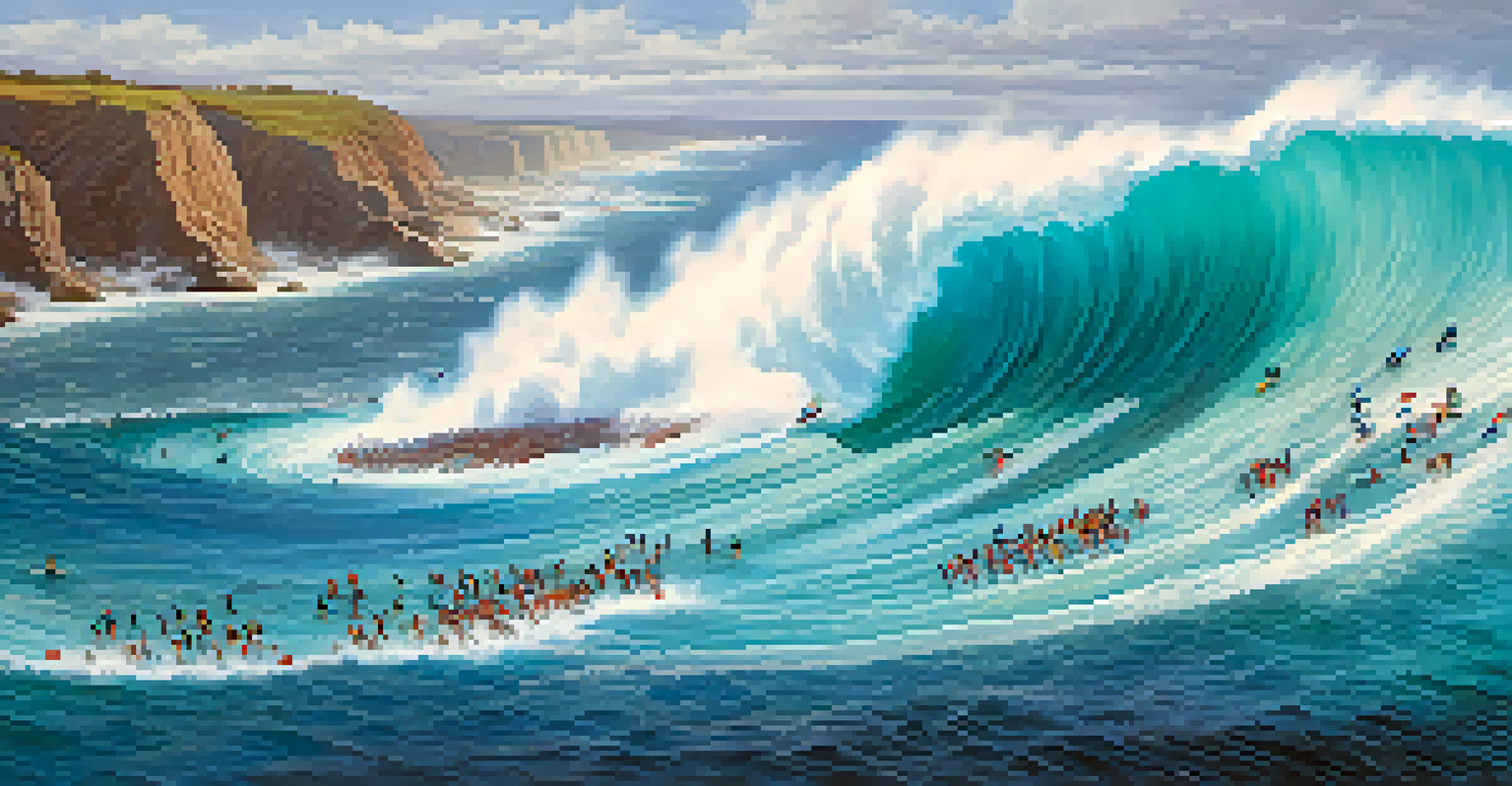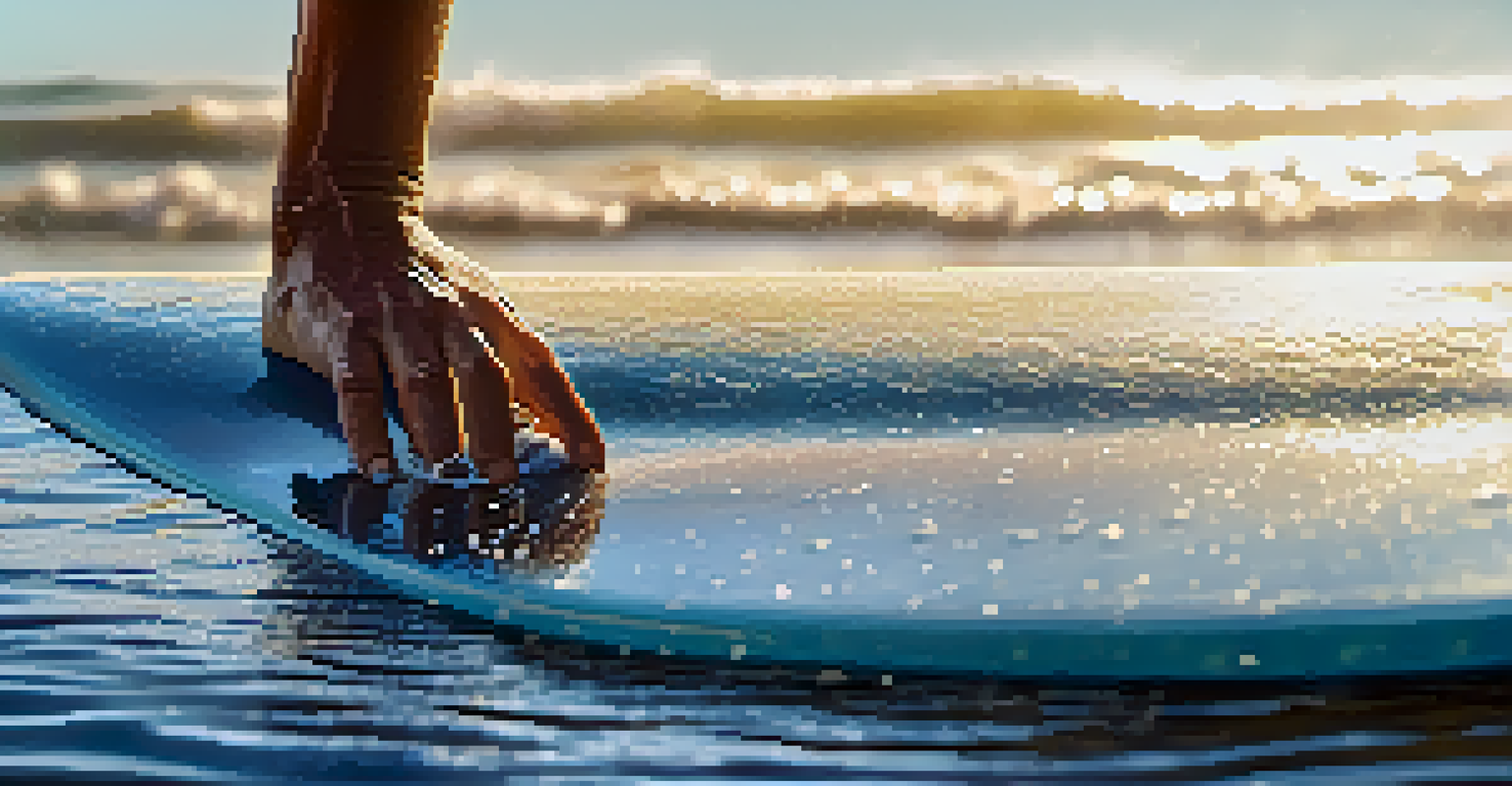Surfing the Big Waves: Tips for Aspiring Big Wave Surfers

Understanding Big Wave Surfing: What You Need to Know
Big wave surfing is not just about riding larger waves; it requires a deep understanding of ocean dynamics. These waves can reach heights of over 20 feet, making them both thrilling and dangerous. Knowing the difference between a regular surf day and a big wave day can save your life. It's essential to respect the ocean and recognize that big waves come with specific challenges.
The ocean stirs the heart, inspires the imagination, and brings eternal joy to the soul.
For those new to the sport, big wave surfing is often associated with iconic locations like Mavericks in California or Jaws in Hawaii. These spots attract experienced surfers, but they also serve as a learning ground for aspiring big wave riders. Understanding the local surf culture and conditions is crucial for any beginner. Take the time to learn from those who have mastered these waters.
Lastly, it's important to approach big wave surfing with humility. Even seasoned surfers can find themselves in precarious situations. Acknowledging your skill level and knowing when to step back can be just as critical as your ability to ride a wave. Remember, the ocean is powerful and unpredictable, so always prioritize safety.
Essential Gear for Big Wave Surfing Success
Having the right gear can make all the difference when it comes to big wave surfing. A sturdy surfboard designed for larger waves is essential; look for boards that are thicker and wider for better stability. Additionally, a wetsuit made for colder waters can protect you from the elements. The right equipment not only enhances performance but also boosts your confidence on the waves.

Consider investing in a tow-in surfboard if you plan on tackling extremely big waves. This type of board is shorter and allows for quick acceleration, letting you catch waves that are otherwise unreachable. Coupled with a jet ski, it can offer a safe way to navigate massive breaks. Remember, the right gear can turn a daunting experience into an exhilarating one.
Safety is Paramount in Surfing
Understanding the risks and prioritizing safety equipment can significantly enhance your big wave surfing experience.
Don't forget about safety equipment! A personal flotation device (PFD) can be a lifesaver, especially in rough conditions. Additionally, a helmet can protect your head from impacts. By prioritizing safety gear, you're taking the necessary steps to ensure that your big wave surfing experience is as safe as it is thrilling.
Physical Conditioning: Preparing Your Body for Big Waves
Big wave surfing demands more than just skill; it requires peak physical condition. Engaging in strength training can help you build the muscles needed to paddle hard and maintain balance on your board. Focus on exercises that target your core, legs, and upper body to develop the strength necessary for big waves. Consistency in your training routine will help you stay fit and ready.
Surfing is like a love affair; you can’t escape it, and you will always be drawn back to it.
Additionally, cardiovascular fitness is crucial for endurance in the water. Consider incorporating activities like running, swimming, or cycling to enhance your stamina. The last thing you want is to tire out when faced with a massive wave. A well-rounded fitness regimen will prepare your body to handle the physical challenges of big wave surfing.
Lastly, flexibility shouldn’t be overlooked. Regular stretching and yoga can improve your balance and agility on the board, making it easier to maneuver during critical moments. A flexible body can help you adapt to the unpredictable nature of the ocean, ensuring that you're ready for whatever comes your way.
Mastering the Art of Wave Reading
One of the most important skills for any surfer is the ability to read waves. Understanding how waves form and break can significantly impact your success in big wave surfing. Spend time observing the ocean, paying attention to wind direction, swell patterns, and the behavior of waves as they approach the shore. This knowledge will help you anticipate when and where to catch the biggest waves.
Knowing the different types of waves and their characteristics is also crucial. For instance, some waves are steep and fast, while others may have a more gradual slope. Each wave presents unique challenges and opportunities. By familiarizing yourself with these traits, you'll be better prepared to make quick decisions while out in the water.
Choose the Right Surf Spot
Selecting suitable locations for your skill level is crucial to building confidence and improving your big wave surfing abilities.
Lastly, consider studying under experienced surfers or taking lessons to improve your wave reading skills. They can provide valuable insights and tips that you may not learn on your own. With practice, you'll develop an instinct for wave reading that will set you apart as a big wave surfer.
Safety First: Understanding the Risks Involved
Big wave surfing can be thrilling, but it's also fraught with risks. Drowning, wipeouts, and collisions are just a few of the dangers that surfers face. Understanding these risks is the first step toward mitigating them. Always be aware of your surroundings and the conditions before heading out, as the ocean can change rapidly.
One way to enhance your safety is to surf with a buddy or as part of a group. Having someone with you can improve your chances of getting help in case of an emergency. Plus, you can look out for each other while riding the waves. Establishing a communication plan with your group is also beneficial for ensuring everyone's safety.
Finally, don’t hesitate to back off if the conditions look too challenging. It's better to wait for another day than to risk your life in dangerous waves. Learning to listen to your instincts and knowing your limits is key to enjoying big wave surfing safely.
Finding the Right Location for Big Wave Surfing
Choosing the right surf spot is crucial for your big wave surfing journey. Some locations are more suitable for beginners, while others cater to advanced surfers. Research potential spots and consider factors such as wave height, local conditions, and crowd levels. Starting at a more manageable location will help build your confidence before tackling the bigger waves.
Popular big wave spots like Waimea Bay and Teahupo'o have specific seasons when the waves are optimal. Timing your surf sessions to these seasons can significantly enhance your experience. Additionally, familiarize yourself with the local rules and etiquette to ensure you respect the surfing community.
Physical and Mental Preparation
Staying in peak physical condition and cultivating a positive mindset are essential for tackling the challenges of big wave surfing.
Lastly, consider visiting less crowded spots to practice your skills without the pressure of competing for waves. Local surf shops or schools can provide insights into hidden gems where you can hone your abilities. Finding the right location can make all the difference in your big wave surfing experience.
Mental Preparation: Building Confidence for Big Waves
The mental aspect of big wave surfing is just as important as the physical preparation. Building confidence in your abilities can mean the difference between riding a wave and being overwhelmed by it. Visualization techniques, where you imagine yourself successfully riding waves, can boost your confidence and set a positive mindset before hitting the water.
Additionally, practice mindfulness and breathing exercises to help manage anxiety. The ocean can be intimidating, but staying calm and focused will improve your performance. Incorporating mental training into your routine will prepare you for the challenges that come with big wave surfing.

Lastly, surround yourself with supportive friends who encourage your journey. Sharing your experiences and fears with fellow surfers can foster a sense of community and provide motivation. Remember, confidence builds over time, so celebrate your progress, no matter how small.
Embracing the Big Wave Surfing Lifestyle
Big wave surfing is more than just a sport; it’s a lifestyle that fosters camaraderie and respect for the ocean. Embracing this lifestyle means connecting with other surfers, sharing stories, and learning from one another. Attend local competitions or surf events to immerse yourself in the community and gain insights from experienced surfers.
Additionally, stay informed about ocean conservation efforts and how you can contribute. Protecting the environment is crucial for the future of surfing, especially in areas vulnerable to climate change. By participating in clean-up events or supporting sustainability initiatives, you’ll help preserve the beauty of the oceans.
Finally, enjoy the journey! Every wave you ride is a step toward improvement. Celebrate your successes and learn from your challenges. Big wave surfing is an adventure filled with ups and downs, and it’s the passion for the ocean that drives you forward.